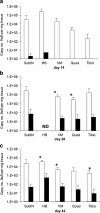Influence of arthritis-related protein (BBF01) on infectivity of Borrelia burgdorferi B31
- PMID: 23651628
- PMCID: PMC3701516
- DOI: 10.1186/1471-2180-13-100
Influence of arthritis-related protein (BBF01) on infectivity of Borrelia burgdorferi B31
Abstract
Background: Lyme borreliosis, caused by tick-borne Borrelia burgdorferi, is a multi-phasic, multi-system disease in humans. Similar to humans, C3H mice develop arthritis and carditis, with resolution and periodic bouts of recurrence over the course of persistent infection. Borrelia burgdorferi arthritis-related protein (Arp/BBF01), a highly conserved protein among B. burgdorferi s.s. isolates, has been shown to be antigenic in humans with Lyme borreliosis, and a target for antibody-mediated disease resolution in the mouse model.
Results: A mutant strain of B. burgdorferi s.s. deficient of the arp gene and a complemented version of that mutant were created and examined for phenotypic effects in mice compared to wild-type B. burgdorferi. Deletion of arp did not abolish infectivity, but did result in a higher infectious dose compared to wild-type B. burgdorferi, which was restored by complementation. Spirochete burdens in tissues of C3H-scid mice were lower when infected with the arp mutant, compared to wild-type, but arthritis was equally severe. Spirochete burdens were also lower in C3H mice infected with the arp mutant, but disease was markedly reduced. Ticks that fed upon infected C3H mice were able to acquire infection with both wild-type and arp mutant spirochetes. Arp mutant spirochetes were marginally able to be transmitted to naïve hosts by infected ticks.
Conclusion: These results indicated that deletion of BBF01/arp did not abrogate, but diminished infectivity and limited spirochete burdens in tissues of both immunocompetent and immunodeficient hosts, and attenuated, but did not abolish the ability of ticks to acquire or transmit infection.
Figures



Similar articles
-
Adaptive immunity in Mus musculus influences the acquisition and abundance of Borrelia burgdorferi in Ixodes scapularis ticks.Appl Environ Microbiol. 2024 Dec 18;90(12):e0129924. doi: 10.1128/aem.01299-24. Epub 2024 Nov 6. Appl Environ Microbiol. 2024. PMID: 39503497 Free PMC article.
-
Presence of Arp specifically contributes to joint tissue edema associated with early-onset Lyme arthritis.Infect Immun. 2014 Jan;82(1):43-51. doi: 10.1128/IAI.01061-13. Epub 2013 Oct 7. Infect Immun. 2014. PMID: 24101694 Free PMC article.
-
Assessment of decorin-binding protein A to the infectivity of Borrelia burgdorferi in the murine models of needle and tick infection.BMC Microbiol. 2008 May 28;8:82. doi: 10.1186/1471-2180-8-82. BMC Microbiol. 2008. PMID: 18507835 Free PMC article.
-
Borrelia burgdorferi protein interactions critical for microbial persistence in mammals.Cell Microbiol. 2019 Feb;21(2):e12885. doi: 10.1111/cmi.12885. Epub 2018 Jul 8. Cell Microbiol. 2019. PMID: 29934966 Free PMC article. Review.
-
Borrelia burgdorferi complement regulator-acquiring surface proteins (BbCRASPs): Expression patterns during the mammal-tick infection cycle.Int J Med Microbiol. 2008 Sep 1;298 Suppl 1(Suppl 1):249-56. doi: 10.1016/j.ijmm.2007.10.002. Epub 2007 Dec 31. Int J Med Microbiol. 2008. PMID: 18165150 Free PMC article. Review.
Cited by
-
Middle region of the Borrelia burgdorferi surface-located protein 1 (Lmp1) interacts with host chondroitin-6-sulfate and independently facilitates infection.Cell Microbiol. 2016 Jan;18(1):97-110. doi: 10.1111/cmi.12487. Epub 2015 Aug 31. Cell Microbiol. 2016. PMID: 26247174 Free PMC article.
-
How Rheumatoid Arthritis Can Result from Provocation of the Immune System by Microorganisms and Viruses.Front Microbiol. 2016 Aug 17;7:1296. doi: 10.3389/fmicb.2016.01296. eCollection 2016. Front Microbiol. 2016. PMID: 27582741 Free PMC article. Review.
-
A Potential Link between Environmental Triggers and Autoimmunity.Autoimmune Dis. 2014;2014:437231. doi: 10.1155/2014/437231. Epub 2014 Feb 12. Autoimmune Dis. 2014. PMID: 24688790 Free PMC article. Review.
-
Antigen-Specific CD4 T Cell and B Cell Responses to Borrelia burgdorferi.J Immunol. 2023 Sep 15;211(6):994-1005. doi: 10.4049/jimmunol.2200890. J Immunol. 2023. PMID: 37556156 Free PMC article.
-
Investigating the potential role of non-vls genes on linear plasmid 28-1 in virulence and persistence by Borrelia burgdorferi.BMC Microbiol. 2016 Aug 8;16(1):180. doi: 10.1186/s12866-016-0806-4. BMC Microbiol. 2016. PMID: 27502325 Free PMC article.
References
Publication types
MeSH terms
Substances
Grants and funding
LinkOut - more resources
Full Text Sources
Other Literature Sources
Medical
Miscellaneous

